I’m not really one to brag publicly about expensive toys, but a few weeks ago I managed to get one that’s really something special. It is a Curta Type II, a mechanical digital1 calculator manufactured in Liechtenstein between the 50s and 70s, before solid-state calculators killed them and the likes of slide-rules.
I have wanted one since I was a kid, and I managed to win an eBay auction for
one. The Curta Type II (and Solomon the cat)
It’s a funny looking device, somewhere between a peppermill and a scifi grenade. Mine has serial number 544065, for those keeping score, and comes in a cute little bakelite pod (which has left hand thread?!).
I wanna talk about this thing because unlike something like a slide rule, it shares many features with modern computers. It has operations, flags, and registers. Its core primitive is an adder, but many other operations can be built on top of it: it is very much a platform for complex calculations.
I’m the sort of person who read Hacker’s Delight for fun, so I really like simple numerical algorithms. This article is a survey of the operation of a Curta calculator and algorithms you can implement on it, from the perspective of a professional assembly programmer.
Many of the algorithms I’m going to describe here exist online, but I’ve found them to be a bit difficult to wrap my head around, so this article is also intended as a reference card for myself.
Let’s dive in!
A Well-Lubricated ALU
There are two Curta models, Type I and Type II, which primarily differ in the sizes of their registers. I have a Type II, so I will focus on the layout of that one.
The Curta is not a stored program computer like the one you’re reading this article on. An operator needs to manually execute operations. It is as if we had taken a CPU and pared it down to two of its most basic components: a register file and an arithmetic logic unit (ALU).
The Register File
The Curta’s register file consists of three digital registers, each of which
contains a decimal integer (i.e., each digit is from 0 to 9, rather than
0 to 1 like on a binary computer):
sr, the setting register, is located on the side of the device. The value insrcan be set manually by the operator using a set of knobs on the side of the device. The machine will never write to it, only read from it. It has 11 digits.rr, the results register, is located at the top of the device along the black part of the dial. It is readable and writable by the machine, but not directly modifiable by the operator. It has 15 digits.cr, the counting register, is located next torralong the silver part of the dial. Likerr, it is only machine-modifiable. It has 8 digits.

sr, set to 1997.
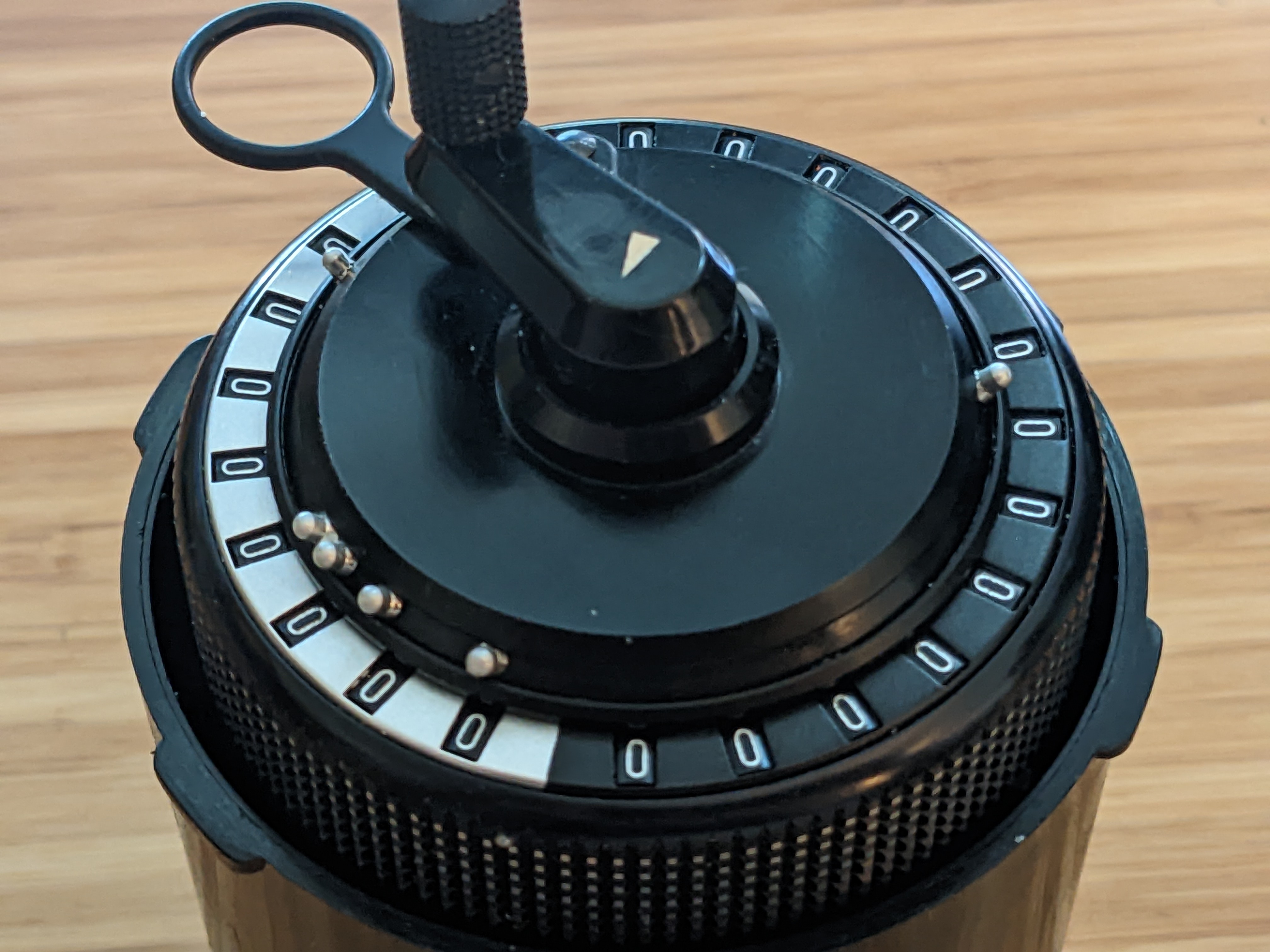
rr is the black dial; cr is the silver one.
There are also two settings on the device that aren’t really registers, but, since they are changed as part of operation, they are a lot like the control registers of a modern computer.
The carriage (there isn’t an abbreviation for this one, so I’ll call it
ca) is the upper knurled ring on the machine. It can be set to a value
from 0 to 72. To set it, the operator lifts the ring up (against
spring tension), twists it, and lets it spring back into the detent for the
chosen value. This is a one-hand motion.
There is a small triangle in the middle of the top of the device that points
at which of the digits in cr will get incremented.
ca raised and in motion.
Finally, rl, the reversing lever, is a small switch near the back of the
device that can be in the up or down position. This is like a flag register:
up is cleared, down is set.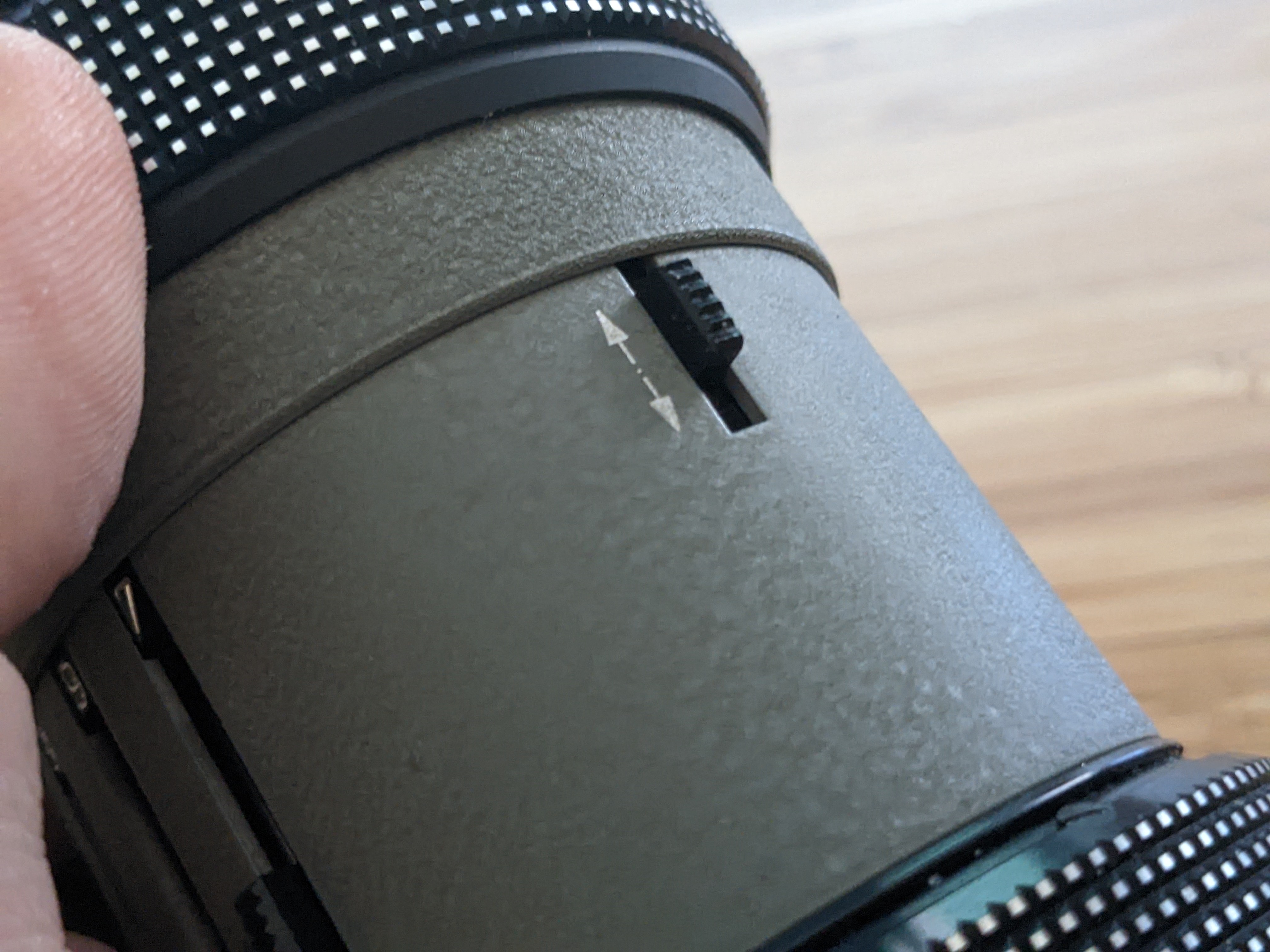
rl in the up position.
The Instruction Set
We have all this memory, but the meat of a machine is what it can do. I will provide an instruction set for the Curta to aid in giving rigorous descriptions of operations you can perform with it.
The core operation of the Curta is “add-with-shift-and-increment”. This is a
mouthful. At the very top of the machine is the handle, which is analogous to a
clock signal pin. Every clockwise turn of this handle executes one of these
operations. Internally, this is implemented using a variation on the
Leibniz gear, a common feature of
mechanical calculators. The handle in “addition” mode.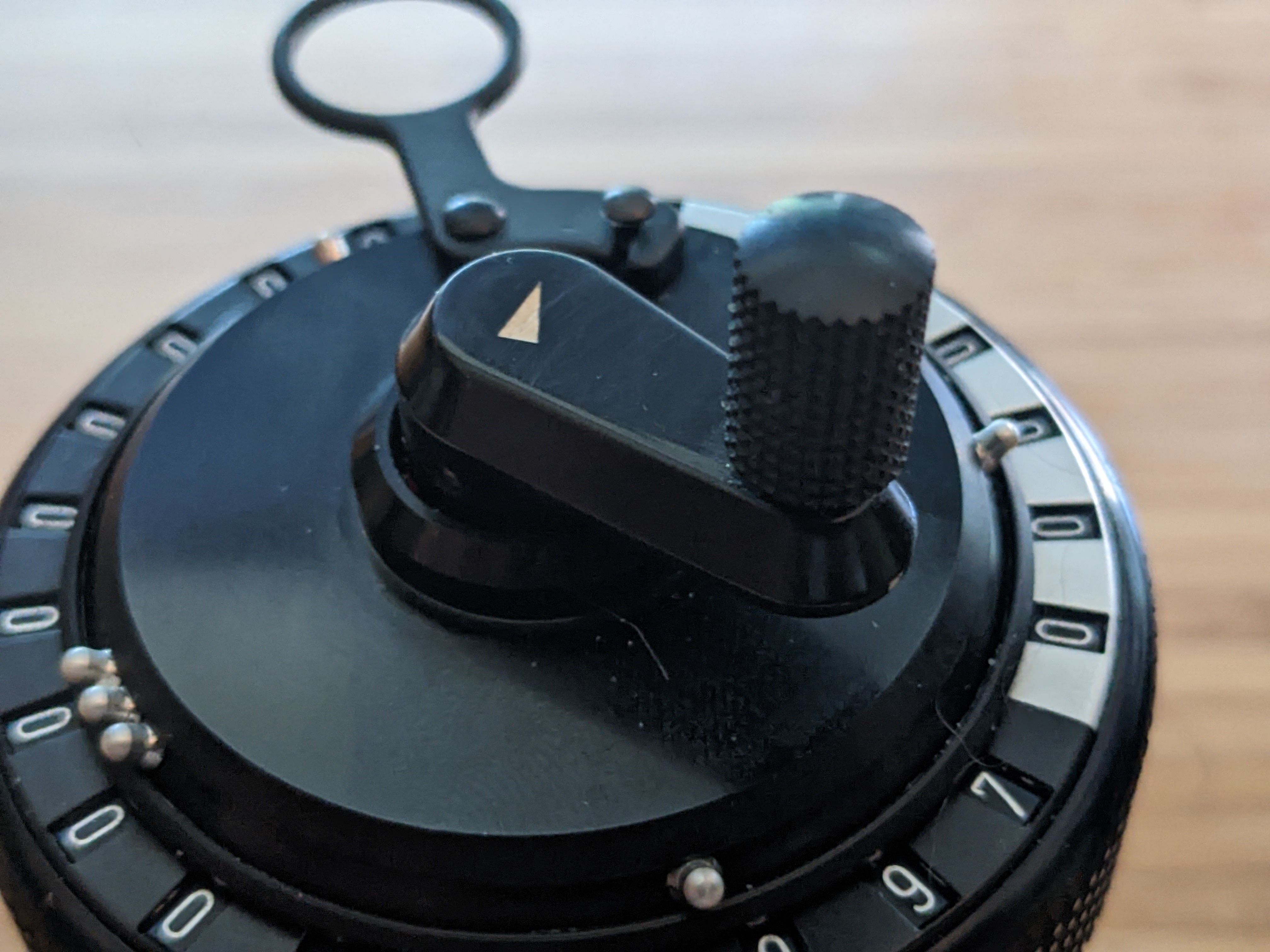
This operation is not that complicated, it just does a lot of stuff.
It takes the value of sr, left-shifts it (in decimal) by the value in ca,
and adds it to rr. Also, it increments CR by 1 shifted by ca. In other
words:
rr += sr << ca
cr += 1 << ca
Recall that this is a decimal machine, so << is the same as multiplication by
a power of 10, not a power of 2.
Addition can overflow, and it wraps around as expected: adding one to
999_999_999_999_999_999 already in rr will fill it with zeroes.
Pulling the handle up reveals a red ring, indicating the machine is in
subtraction mode. This flips the signs of both the rr and cr
modifications:
rr -= sr << ca
cr -= 1 << ca
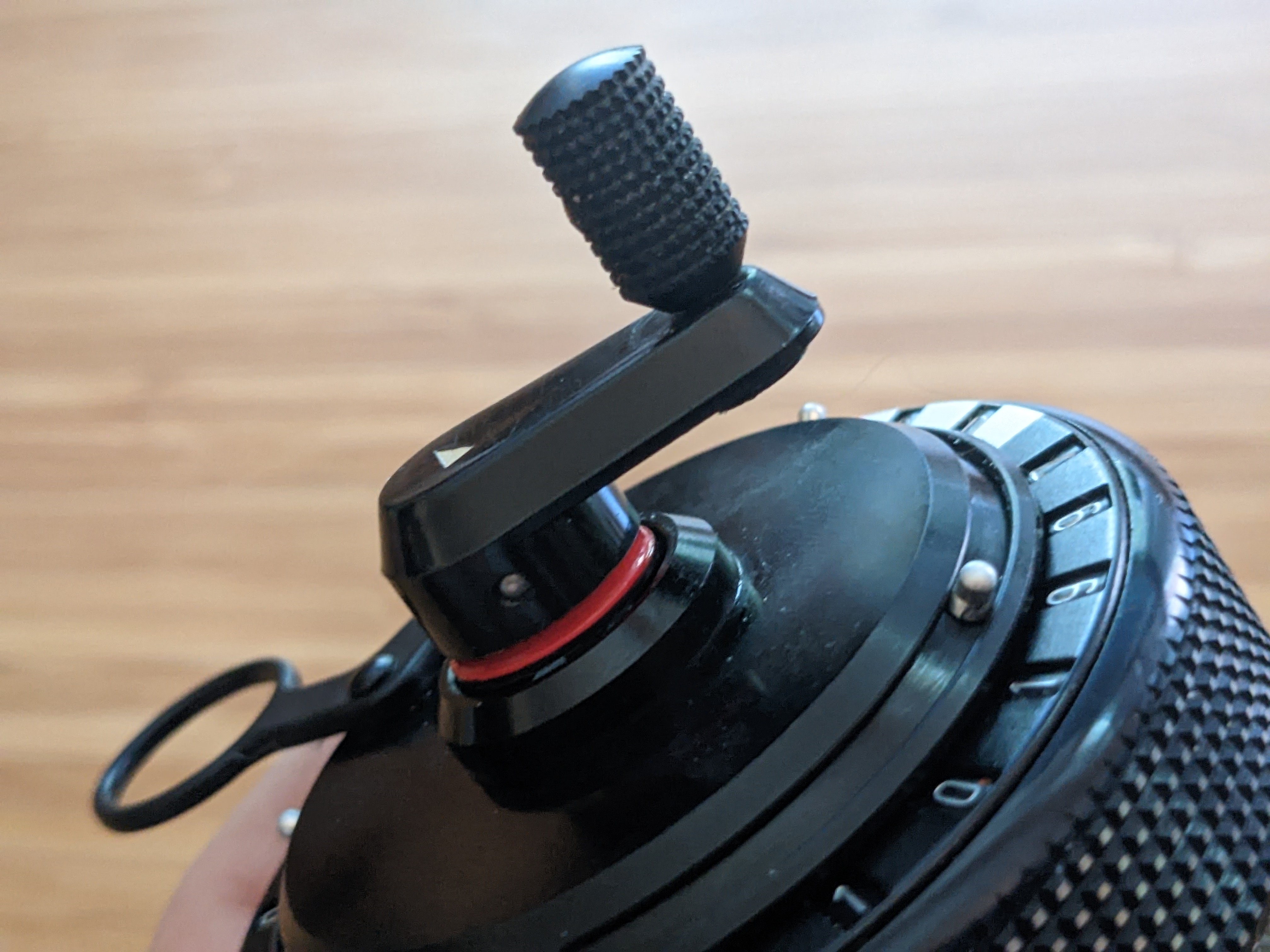
The handle in “subtraction” mode.
The Curta cannot handle negative numbers, so it will instead display the ten’s
complement3 of a negative result. For example, subtracting 1 from 0
will produce all-nines.
You can detect when underflow or overflow occurs when the resulting value is
unexpectedly larger or smaller than the prior value in rr, respectively.
(This trick is necessary on architectures that lack a carry flags register,
like RISC-V.)
Setting rl will reverse the sign of the operation done on cr during a
turn of the handle. In addition mode, it will cause cr to be subtracted from,
while in subtraction mode, it will cause it to be added to. Some complex
algorithms make use of this.
Finally, the clearing lever can be used to clear (to zero) The clearing lever.sr or rr,
independently. It is a small ring-shaped lever that, while the carriage is
raised, can be wiped past digits to clear them. Registers cannot be partially
Notation
Let’s give names to all the instructions the operator needs to follow, so we can write some assembly:
mr, or Machine Ready!, means to clear/zero every register. All Curta instructions use the term “Machine Ready” to indicate the beginning of a calculation session.pturnis the core addition operation, a “plus turn”.mturnis its subtraction twin, a “minus turn”.set <flag>requests the operator set one ofrlorsm.clr <flag>is the opposite ofset.zero <reg>request a clear of one ofrrorcrusing the clearing lever.add <reg>, <imm>requests manual addition of an immediate tosrorca. This is limited by what mental math we can ask of the operator.copy <reg>, srrequests a copy of the value inrrorcrtosr.wrnp <reg>, <symbol>indicates we need to write down a value in any register to a handy notepad (hencewritenotepad), marked with<symbol>.rdnp <reg>, <symbol>asks the operator toread a value recorded withwrnp.if <cond>, <label>asks the operator to check a condition (in terms ofcr,rr, andsr) and, if true, proceed to the instruction at the givenlabel:. Here’s some examples of conditions we’ll use:rr == 42, i.e.,rrequals some constant value.rr.ovflow, i.e.,rroverflowed/underflowed due to the most recentpturn/mturn.cr[1] == 9, i.e.cr’s second digit (zero-indexed, not like the physical device!) equals9.cr[0..ca] < sr[0..ca], i.e.,cr, considering only the digits up to the setting ofca, is less than those same digits insr.
goto <label>is likeifwithout a condition.donemeans we’re done and the result can be read off ofrr(orcr).
Note that there is a lot of mental math in some of the conditions. Algorithms on the Curta are aimed to minimize what work the operator needs to do to compute a result, but remember that it is only an ALU: all of the control flow logic needs to be provided by the human operator.
None of this is real code, and it is specifically for the benefit of readers.
Some Algorithms
So, addition and subtraction are easy, because there are hardware instructions for those. There is, however, no direct way to do multiplication or division. Let’s take a look at some of our options.
Given that a Curta is kinda expensive, you can try out an online simulator if you want to follow along. This one is pretty simple and runs in your browser.
Multiplication
The easiest way to do multiplication is by repeated addition; cr helps us
check our work.
Given a value like 8364, we can multiply it by 5 like so:
mul_by_5:
mr
add sr, 8364
loop:
if cr == 5, end
pturn
goto loop
end:
done
Here, we input the larger factor into sr, and then keep turning until cr
contains the other factor. The result is 41820: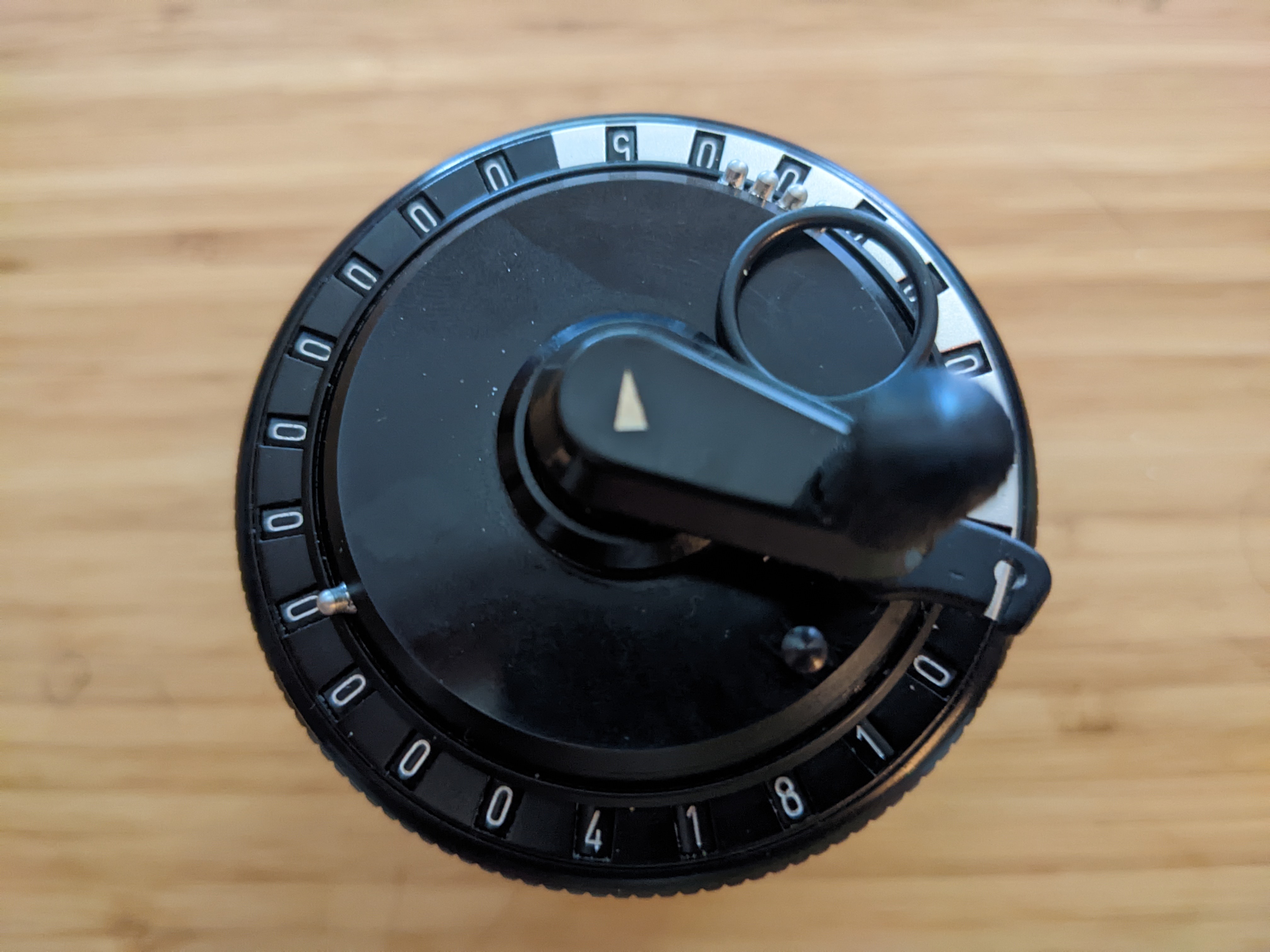
8364 * 5 == 41820
Of course, this does not work well for complex products, such as squaring
41820. You could sit there and turn the handle forty thousand times if you
wanted to, or you might decided that you should get a better hobby, since modern
silicon can do this in nanoseconds.
We can speed this up exponentially by making use of the distributive property
and the fact that turn can incorporate multiplication by a power of 10.
Consider:
41820 * 41820
= 41820 * (40000 + 1000 + 800 + 20)
= 41820 * 40000 + 41820 * 1000 + 41820 * 800 + 41820 * 20
Each nice round number here can be achieved in cr by use of ca. Our
algorithm will look a bit like this:
square:
mr
add sr, 41820
loop:
// Check if we're done.
if cr == 41820, end
inner:
// Turn until the first `ca` digits of `cr` and the
// other factor match.
if cr[1..ca] == 41802[1..ca], inner_end
pturn
goto inner
inner_end:
// Increment `ca` and repeat until done.
add ca, 1
goto loop
end:
done
There are two loops. The inner loop runs as many turns as is necessary to get
the next prefix of the factor into cr, then incrementing ca to do the next
digit, and on and on until cr contains the entire other factor, at which point
we can read off the result.
The actual trace of operations (omitting control flow), and the resulting
contents of the registers sr/rr/mr/ca at each step, looks something like
this:
mr
// 00000000000/000000000000000/00000000/0
add sr, 41820
// 00000041820/000000000000000/00000000/0
add ca, 1
// 00000041820/000000000000000/00000000/1
pturn
// 00000041820/000000000418200/00000010/1
pturn
// 00000041820/000000000083640/00000020/1
add ca, 1
// 00000041820/000000000083640/00000020/2
pturn
// 00000041820/000000005018400/00000120/2
pturn
// 00000041820/000000009200400/00000220/2
pturn
// 00000041820/000000013382400/00000320/2
pturn
// 00000041820/000000017564400/00000420/2
pturn
// 00000041820/000000021746400/00000520/2
pturn
// 00000041820/000000025928400/00000620/2
pturn
// 00000041820/000000030110400/00000720/2
pturn
// 00000041820/000000034292400/00000820/2
add ca, 1
// 00000041820/000000034292400/00000820/3
pturn
// 00000041820/000000076112400/00001820/3
add ca, 1
// 00000041820/000000494312400/00011820/4
pturn
// 00000041820/000000912512400/00021820/4
pturn
// 00000041820/000001330712400/00031820/4
pturn
// 00000041820/000001748912400/00041820/4
pturn
The result can be read off from rr: 1748912400. In the trace, you can see
cr get built up digit by digit, making this operation rather efficient.
41820 * 41820 == 1748912400
We can do even better, if we use subtraction. For example, note that
18 = 20 - 2; we can build up 18 in cr by doing only 4 turns rather than
nine, according to this formula. Here’s the general algorithm for n * m:
mul:
mr
add sr, n
loop:
if cr == m, end
// Same as before, but if the next digit is large,
// go into subtraction mode.
if m[ca] > 5, by_sub
inner:
if cr[0..ca] == m[0..ca], inner_end
pturn
goto inner
by_sub:
// Store the current `ca` position.
wrnp ca, sub_from
// Find the next small digit (eg. imagine n * 199, we
// want to find the 1).
find_small:
add ca, 1
if m[ca] > 5, find_small
// Set the digit to one plus the desired value for that
// digit.
outer_turns:
pturn
if cr[ca] != m[ca] + 1, outer_turns
// Store how far we need to re-advance `ca`.
wrnp ca, continue_from
// Go back to the original `ca` position and enter
// subtraction mode.
rdnp ca, sub_from
subs:
subs_inner:
// Perform subtractions until we get the value we want.
if cr[ca] == m[ca], subs_end
mturn
goto subs_inner
subs_end:
// Advance `ca` and keep going until we're done.
add ca, 1
if ca != continue_from, subs
goto loop
inner_end:
add ca, 1
goto loop
end:
done
Although more complicated, if we execute it step by step, we’ll see we get to our answer in fewer turns:
mr
// 00000000000/000000000000000/00000000/0
add sr, 41820
// 00000041820/000000000000000/00000000/0
add ca, 1
// 00000041820/000000000000000/00000000/1
pturn
// 00000041820/000000000418200/00000010/1
pturn
// 00000041820/000000000835400/00000020/1
add ca, 2
// 00000041820/000000000835400/00000020/3
pturn
// 00000041820/000000042656400/00001020/3
pturn
// 00000041820/000000084476400/00002020/3
add ca, -1
// 00000041820/000000084476400/00002020/2
mturn
// 00000041820/000000080294400/00001920/2
mturn
// 00000041820/000000076112400/00001820/2
add ca, 2
// 00000041820/000000494312400/00011820/4
pturn
// 00000041820/000000912512400/00021820/4
pturn
// 00000041820/000001330712400/00031820/4
pturn
// 00000041820/000001748912400/00041820/4
pturn
In exchange for a little overhead, the number of turns drops from 15 to 10. This is the fastest general algorithm, but some techniques from Hacker’s Delight can likely be applied here to make it faster for some products.
Cubes
As a quick note, computing the cube of a number without taking extra notes is
easy, so long as the number is already written down somewhere you can already
see it. After computing n^2 by any of the methods above, we can do
cube:
mr
add sr, n
// Perform a multiplication by `n`, then copy the result
// into `sr`.
copy sr, rr
zero rr
zero cr
// Perform another multiplication by `n`, but now with
// its square in `sr`.
done
This sequence can be repeated over and over to produce higher powers, and is
only limited by the size of rr.
Division
Division is way more interesting, because it can be inexact, and thus produces a remainder in addition to the quotient. There are a few different algorithms, but the simplest one is division by repeated subtraction. Some literature calls this “division by breaking down”.
For small numbers, this is quite simple, such as 21 / 4:
div_by_4:
mr
add sr, 21
pturn
zero cr
zero sr
add sr, 4
set rl
loop:
if rr.oflow, end
mturn
goto loop
end:
pturn
done
This works by first getting the dividend into rr and resetting the rest of
the machine. Then, with rl set, we subtract the divisor from rr until we
get overflow, at which point we add to undo the overflow. The quotient will
appear in cr: we set rl, so each subtraction increments cr, giving us
a count of mturns executed. The remainder appears in rr.
In this case, we get down to 1 before the next mturn underflows; the result
of that underflow is to 99...97, the ten’s complement of -3. We then undo the
last operation by pturning, getting 5 in cr: this is our quotient. 1 in
rr is the remainder.
The same tricks from earlier work here, using ca to make less work,
effectively implementing decimal long division of n/m:
div:
// Set up the registers.
mr
add sr, n
pturn
zero cr
zero sr
add sr, m
set rl
// Move `ca` to be such that the highest digit of
// `sr` lines up with the highest digit of `rr`.
add ca, log(m) - log(n) + 1
loop:
// Make subtractive turns until we underflow.
inner:
mturn
if !rr.ovflow, inner
// Undo the turn that underflowed by doing an addition.
// Because `rl` is set, this will also conveniently subtract
// from `cr`, to remove the extra count from the
// underflowing turn.
pturn
// We're done if this is the last digit we can be subtracting.
// Otherwise, decrement `ca` and start over.
if ca == 0, done
add ca, -1
goto loop
end:
done
Let’s execute this on 3141592653 / 137, with an instruction trace as before.
mr
// 00000000000/000000000000000/00000000/0
add sr, 3141592653
// 03141592653/000000000000000/00000000/0
pturn
// 03141592653/000003141592653/00000001/0
zero cr
// 03141592653/000003141592653/00000000/0
zero sr
// 00000000000/000003141592653/00000000/0
add sr, 137
// 00000000137/000003141592653/00000000/0
add ca, 7
// 00000000137/000003141592653/00000000/7
mturn
// 00000000137/000001771592653/10000000/7
turn
// 00000000137/000000401592653/20000000/7
turn
// 00000000137/999990031592653/30000000/7
pturn
// 00000000137/000000401592653/20000000/7
add ca, -1
// 00000000137/000000401592653/20000000/6
mturn
// 00000000137/000000264592653/21000000/6
mturn
// 00000000137/000000127592653/22000000/6
mturn
// 00000000137/999999990592653/23000000/6
pturn
// 00000000137/000000127592653/22000000/6
add ca, -1
// 00000000137/000000127592653/22000000/5
// More turns...
add ca, -1
// 00000000137/000000004292653/22900000/4
// More turns...
add ca, -1
// 00000000137/000000000182653/22930000/3
// ...
add ca, -1
// 00000000137/000000000045653/22931000/2
// ...
add ca, -1
// 00000000137/000000000004553/22931300/1
// ...
add ca, -1
// 00000000137/000000000000443/22931330/0
// ...
done
// 00000000137/000000000000032/22931333/0
For a quotient this big, you’ll need to work through all eight cr digits,
which is a ton of work. At the end, we get a quotient of 22931333 and
reminder 32.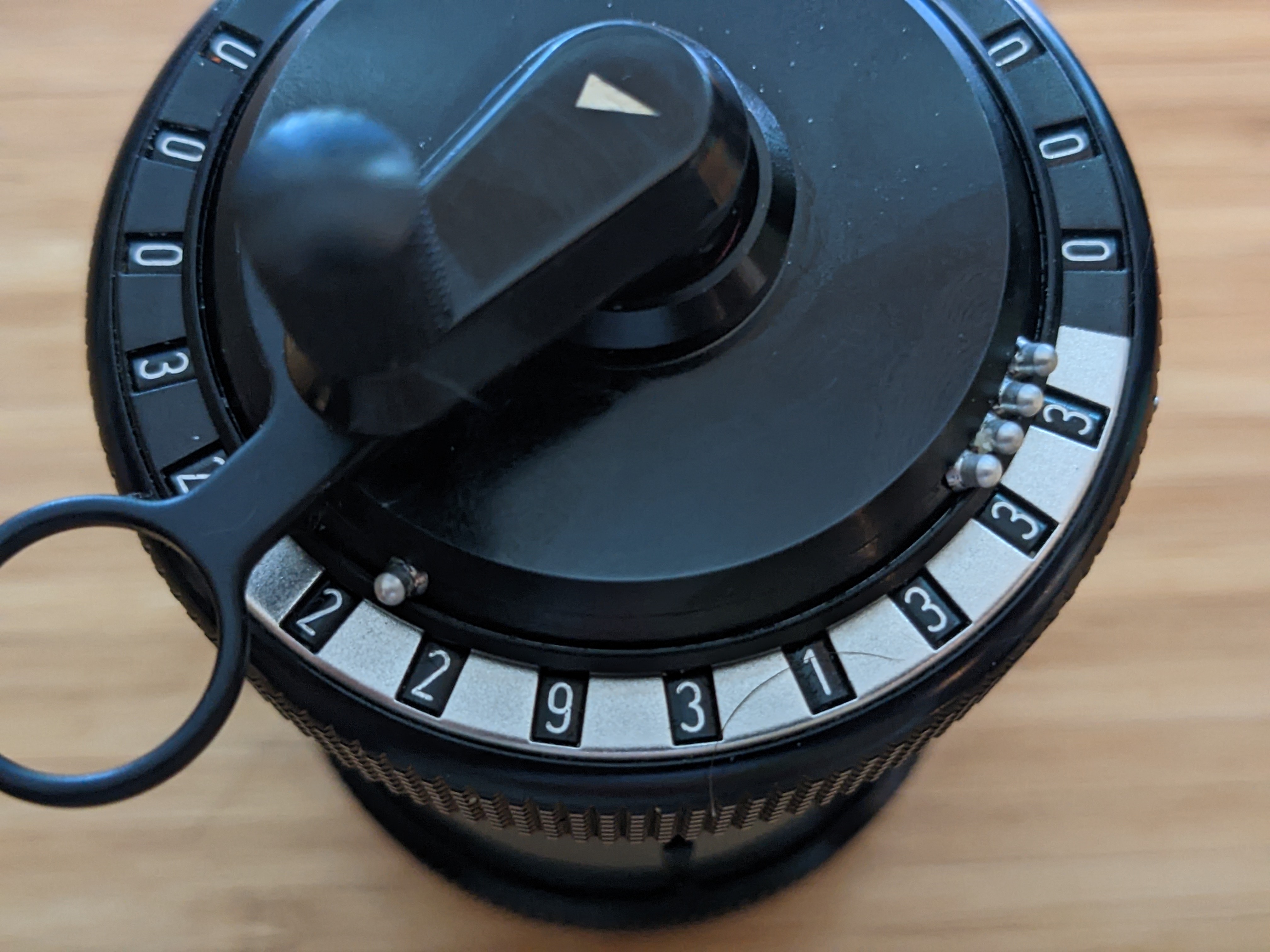
3141592653 / 137 == 22931333, rem 32
Unfortunately, we can’t as easily “cheat” with subtraction as we did with
multiplication, because we don’t know the value that needs to appear in cr.
Square Roots
Computing square roots by approximation is one of the premiere operations on the Curta. There’s a number of approaches. Newton’s method is the classic, but requires a prior approximation, access to lookup tables, or a lot of multiplication.
A slower, but much more mechanical approach is to use Töpler’s method. This
consists of observing that the sum of the first n odd numbers is the square of
n. Thus, we can use an approach similar to that for division, only that we
now subtract off consecutive odd numbers. Let’s take the square root of 92:
sqrt_of_92:
mr
add sr, 92
pturn
zero cr
zero sr
add sr, 1
set rl
loop:
mturn
if rr.ovflow, end
add sr,
goto loop
end:
pturn
done
We get 9 as our result, but that’s pretty awful precision. We can improve
precision by multiplying 92 by a large, even power of ten, and then dividing
the result by that power of ten’s square root (half the zeroes).
Unfortunately, this runs into the same problem as naive multiplication: we have to turn the handle a lot. Turning this algorithm into something that can be done exponentially faster is a bit fussier.
One approach (which I found on <curta.org>) allows us to compute the root by shifting. Several programmers appear to have independently discovered this in the 70s or 80s.
It is based on the so-called “digit-by-digit” algorithm, dating back to at least the time of Napier. Wikipedia provides a good explanation of why this method works. However, I have not been able to write down a proof that this specific version works, since it incorporates borrowing to compute intermediate terms with successive odd numbers in a fairly subtle way. I would really appreciate a proof, if anyone knows of one!
The algorithm is thus, for a radicand n:
sqrt:
mr
// Put `ca` as far as it will go, and then enter
// the radicand as far right as it will go, so you
// get as many digits as possible to work with.
add ca, 8
add sr, n << (8 - log(n))
pturn
zero cr
zero sr
// Put a 1 under the leftmost pair of digits. This
// assumes a number with an even number of digits.
add sr, 1 << (ca - 1)
set rl
loop:
sqrt_loop:
// Add an odd number (with a bunch of zeros
// after it.)
mturn
if rr.ovflow, sqrt_end
// Increment sr by 2 (again, with a bunch of
// zeros after it). This gives us our next odd
// number.
add sr, 2 << (ca - 1)
goto sqrt_loop
sqrt_end:
// Note that we do NOT undo the increment of `sr`
// that caused overflow, but we do undo the last
// mturn.
pturn
// If `ca` is all the way to the right, we're out of
// space, so these are all the digits we're getting.
// Zeroing out `rr` also means we're done.
if ca == 1 || rr == 0, end
// Subtract ONE from the digit in `sr` we were
// incrementing in the loop. This results in an even
// number.
add sr, -(1 << (ca - 1))
// Decrement `ca` and keep cranking.
add ca, -1
add sr, 1 << (ca - 1)
goto loop
end:
done
Let’s compute some digits of sqrt(2). Here’s the instruction trace.
mr
// 00000000000/000000000000000/00000000/0
add ca, 7
// 00000000000/000000000000000/00000000/7
add sr, 2 << (8 - log(n))
// 00020000000/000000000000000/00000000/7
pturn
// 00020000000/200000000000000/10000000/7
zero cr
// 00020000000/200000000000000/00000000/7
zero sr
// 00000000000/200000000000000/00000000/7
add sr, 1 << (ca - 2)
// 00010000000/200000000000000/00000000/7
mturn
// 00010000000/100000000000000/10000000/7
add sr, 2 << (ca - 2)
// 00030000000/100000000000000/10000000/7
mturn
// 00030000000/800000000000000/10000000/7
pturn
// 00030000000/100000000000000/10000000/7
add sr, -(1 << (ca - 2))
// 00020000000/100000000000000/10000000/7
add ca, -1
// 00020000000/100000000000000/10000000/6
add sr, 1 << (ca - 2)
// 00021000000/100000000000000/10000000/6
mturn
// 00021000000/079000000000000/11000000/6
add sr, 2 << (ca - 2)
// 00023000000/079000000000000/11000000/6
mturn
// 00023000000/056000000000000/12000000/6
add sr, 2 << (ca - 2)
// 00025000000/056000000000000/12000000/6
mturn
// 00025000000/031000000000000/13000000/6
add sr, 2 << (ca - 2)
// 00027000000/031000000000000/13000000/6
mturn
// 00027000000/004000000000000/14000000/6
add sr, 2 << (ca - 2)
// 00029000000/004000000000000/14000000/6
mturn
// 00029000000/975000000000000/15000000/6
pturn
// 00029000000/004000000000000/14000000/6
add sr, -(1 << (ca - 2))
// 00028000000/004000000000000/14000000/6
add ca, -1
// 00028000000/004000000000000/14000000/5
// More of the same...
Over time, the digits 14121356 will appear in cr. This is the square root
(although we do need to place the decimal point; the number of digits before it
will be half of what we started with, rounded up).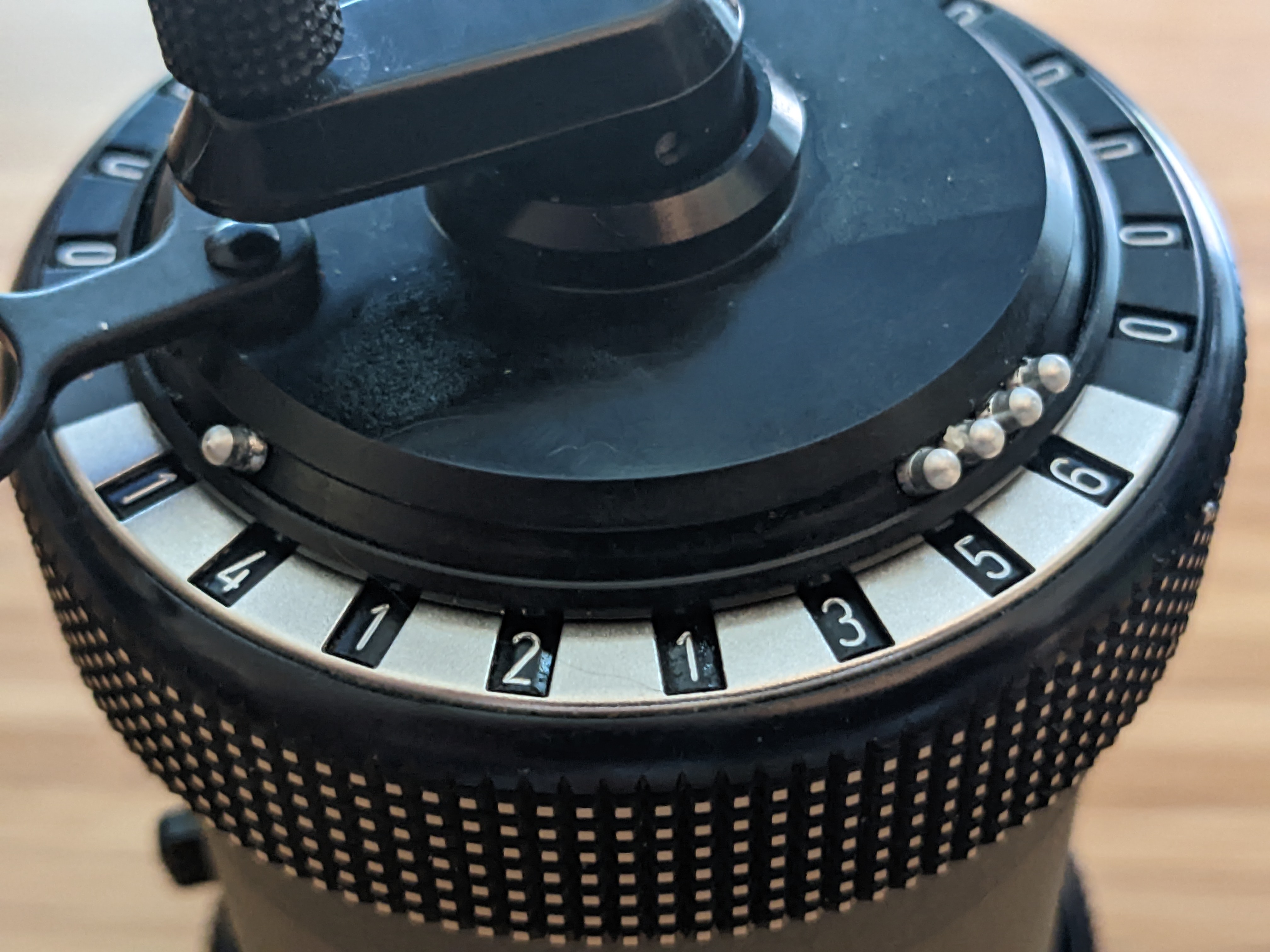
sqrt(2) ~ 1.4121356
Wrap-up
There’s a quite a few other algorithms out there, but most of them boil down to
clever use of lookup tables and combinations of the above techniques. For
example, the so-called “rule of 3” is simply performing a multiplication to get
a product into rr, and then using it as the dividend to produce a quotient
of the form a * b / c in cr.
I hope that these simple numeric algorithms, presented in a style resembling assembly, helps illustrate that programming at such a low level is not hard, but merely requires learning a different bag of tricks.
Although this seems like an oxymoron, it is accurate! The Curta contains no electrical or electronic components, and its registers contain discrete symbols, not continuous values. It is not an analog computer! ↩︎
The Curta is a one-indexed machine, insofar as the values engraved on
caare not0to7but1to8. However, as we all know, zero-indexing is far more convenient. Any place where I say “setcaton”, I mean then + 1th detent.Doing this avoids a lot of otherwise unnecessary
-1s in the prose. ↩︎The ten’s complement of a number
xis analogous to the two’s complement (i.e., the value of-xwhen viewed as an unsigned integer on a binary machine). It is equal toMAX_VALUE - x + 1, whereMAX_VALUEis the largest value thatxcould be. For example, this is999_999_999_999_999_999(fifteen nines) forrr. ↩︎